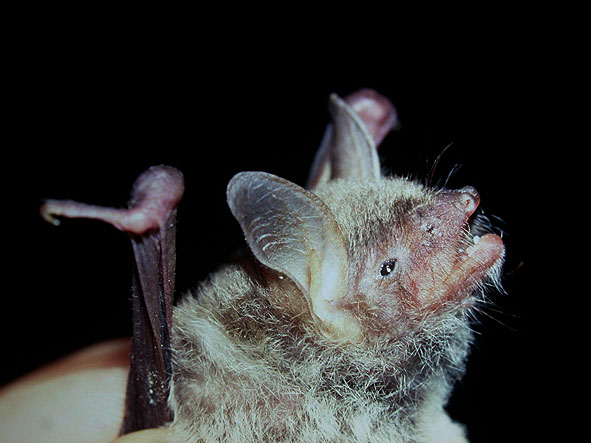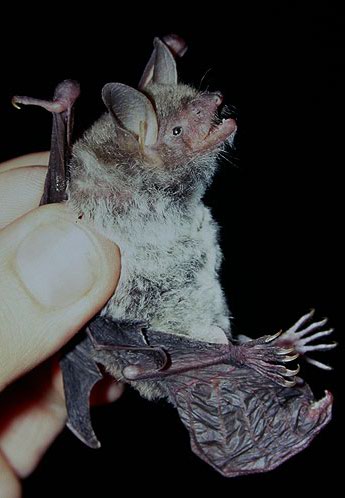Myotis pequinius
Peking Myotis
Morphological description Life history Distribution Habitat Roost sites and roosting patterns Emergence and flight pattern Foraging behaviour Echolocation calls Status and protection


Morphological Description
· Dorsal fur is brown. Ventral fur is grey or white-grey.
· Forearm length 49.6-53.0mm. Average wingspan is 34.2cm (Range 34.00-34.6). (Jones et al. 2006).
· Relatively long ears (15-16 mm) (Jones et al. (2006).
· Body mass 9.8-11.5g from bats captured in April (Jones et al. 2006). Jones et al. (2006) reported one individual's body mass reaches 14.05g in November.
· Skull measurements of this and related species given in the table below (from Jones et al. 2006). All measurements are in mm.
|
Myotis pequinius Series 1 |
Myotis pequinius Series 2 |
Myotis cf. pequinius
|
Myotis bombinus bombinus |
Myotis bombinus amurensis |
Myotis nattereri |
Myotis schaubi
|
Myotis tschuliensis
|
|
(n=3) |
(n=2) |
NMP 90556 |
(n=7) |
(n=2) |
(n=117) |
(n=9) |
(n=15) |
greatest skull length |
18.20 |
19.98 |
16.40 |
14.91 |
15.25 |
15.76 |
17.18 |
16.12 |
condylobasal length |
17.70 |
17.75 |
15.13 |
14.03 |
14.17 |
14.72 |
16.12 |
15.13 |
zygomatic width |
12.00 |
11.79 |
10.59 |
9.25 |
9.40 |
9.93 |
10.69 |
10.15 |
interorbital width |
4.75 |
5.38 |
3.75 |
3.69 |
3.80 |
3.83 |
4.08 |
3.69 |
upper canines width |
5.25 |
5.11 |
4.10 |
3.75 |
3.91 |
4.05 |
4.49 |
4.10 |
upper tooth-row length |
7.02 |
7.39 |
6.33 |
5.73 |
5.81 |
6.13 |
6.74 |
6.40 |
mandible length |
14.37 |
14.68 |
12.02 |
10.81 |
10.90 |
11.48 |
12.55 |
11.81 |
lower tooth-row length |
7.43 |
7.76 |
6.62 |
6.14 |
6.05 |
6.51 |
7.18 |
6.78 |
· A smaller bat captured by Petr Benda in Daguping, Foping District , Shaanxi Province (33°35'N, 107°46'E; ca. 1190 m a. s. l.) had a forearm length of 43.8 mm and was phylogenetically distinct from the M. pequinius captured at Fo-Guang Temple. It is refereed to here and in Jones et al. (2006) as Myotis cf. pequinius, and may represent an undescribed species.
Life history
· Little known.
Distribution
Endemic to China with a restricted range (found in central eastern regions). The Chinese distribution is shown by dots on the map (as given by Zhang et al. (1997). The red dot shows a new record from our field surveys (Fo-Guang Temple site).

Habitat
· Little known.
Roost sites and roosting behaviour
· There is a big colony, with thousands of individuals, roosting in a old temple called Fo-Guang Temple, Shanxi province (Jones et al., 2006). Hibernates in caves.
Emergence and flight pattern
· Flight morphology parameters as defined by Norberg & Rayner (1987) are listed below (means and range). From Jones et al. (2006). The wing morphology shows that this species has relatively large ears and is relatively broad winged: it resembles a scaled-up version of the Palaearctic M. nattereri to which it is closely related. Like M. nattereri, it probably hunts close to clutter. Emerged late at Fo-Guang Temple, in quite dark conditions.
Body mass (g) 10.89: 9.8-11.5; n = 14, April; 14.05 n = 1, November
Forearm length (mm) 50.27: 49.6-50.7
Hand wing area (cm 2 ) 67.01: 66.70-67.54
Arm wing area (cm 2 ) 91.45: 87.34-94.40
Wing area (cm 2 ) 190.25: 188.56-191.10
Wing span (cm) 34.23: 34.00-34.60
Hand wing length (cm) 8.33: 8.00-8.50
Arm wing length (cm) 7.07: 6.70-7.30
Tip Length Ratio 1.18: 1.10-1.27
Tip Area Ratio 0.73: 0.71-0.77
Tip Shape Index 1.66: 1.49-1.93
Aspect Ratio 6.16: 6.05-6.35
Wing loading (Nm -2 ) 5.62-7.24
Foraging behaviour
· Diet of bats at Fo-Guang Temple comprised 80% Coleoptera, 10% Hemiptera, 5% Lepidoptera, 3.5% Diptera, with traces of Odonata, Acari (probably mites ingested while grooming, or parasites of beetles) and lepidopteran larvae. Lepidopteran larvae may be captured when hanging from threads (Jones et al. 2006).
Echolocation calls
. A waveform and spectrogram of echolocation calls emitted in open space (left) and closer to clutter (right) are given below. From Jones et al. (2006).
Call characteristics (means +/- SD) are taken from Jones et al. (2006).
Pulse interval (ms) 93.38 +/-30.26
Pulse duration (ms) 5.72 +/-1.04
Upper frequency (kHz) 84.18 +/- 10.06
Lowest frequency (kHz) 16.86 +/-1.71
Frequency of most energy (kHz) 32.80 +/- 5.82
Status and protection
· There is no estimation of population size for this endemic species.
· The most famous colony roosts in Fo-Guang Temple, Shanxi province, which is oldest wooden building in the world (857 AD). Several thousand Peking myotis bats occupy the roof of this building.
· Peking myotis bats are at LR/nt, assessed by the Red List of Threatened Species (IUCN, 2006) and are not listed in the Law of the People's Republic of China on the Protection of Wildlife in 1989. Their restricted range and endemic nature gives cause for conservation concern.
· Caves and old buildings should be protected as their habitats.